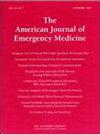Endophthalmitis due to a retained intraocular metallic object
IF 2.2
3区 医学
Q1 EMERGENCY MEDICINE
引用次数: 0
Abstract
Endophthalmitis is a sight-threatening infection for which prompt diagnosis and treatment is central to improving patient outcomes. Diagnosing endophthalmitis can be difficult in the emergency department (ED), as its symptoms may be nonspecific and definitive testing equipment is delicate, requiring a high degree of familiarity to operate correctly. We present the case of a 42-year-old man who presented to the ED following a traumatic ocular injury. Fluorescein staining revealed a corneal abrasion. The patient was prescribed erythromycin ointment and a follow-up appointment with outpatient ophthalmology was recommended. Five days later, the patient presented to the ED again complaining of increasing eye pain, inflammation, and blurred vision. Initial examination of the eye revealed chemosis and corneal infiltrate, indicative of endophthalmitis. Repeat fluorescein staining found no corneal abrasion, though a slit lamp exam located a retained metallic foreign body within the anterior chamber. The patient was treated with fluoroquinolone drops and transferred to a comprehensive eye center for aggressive management. This case highlights the importance of comprehensive ocular exam using a slit lamp following ocular trauma. Timely diagnosis and treatment with intravitreal antibiotics are essential to prevent loss of vision.
眼内金属物残留引起的眼内炎。
眼内炎是一种威胁视力的感染,及时诊断和治疗是改善患者预后的关键。在急诊科(ED)诊断眼内炎是很困难的,因为它的症状可能是非特异性的,并且明确的检测设备是精密的,需要高度熟悉才能正确操作。我们提出的情况下,一个42岁的男子谁提出了ED后创伤性眼损伤。荧光素染色显示角膜磨损。患者开红霉素软膏,并建议随访预约门诊眼科。5天后,患者再次出现在急诊科,主诉眼睛疼痛加重、炎症和视力模糊。眼部初步检查发现化脓和角膜浸润,提示眼内炎。重复荧光染色未发现角膜磨损,但裂隙灯检查发现前房内有残留的金属异物。患者给予氟喹诺酮滴剂治疗,并转至综合眼科中心进行积极治疗。本病例强调了眼外伤后使用裂隙灯进行全面眼科检查的重要性。及时诊断和使用玻璃体内抗生素治疗对防止视力丧失至关重要。
本文章由计算机程序翻译,如有差异,请以英文原文为准。
求助全文
约1分钟内获得全文
求助全文
来源期刊
CiteScore
6.00
自引率
5.60%
发文量
730
审稿时长
42 days
期刊介绍:
A distinctive blend of practicality and scholarliness makes the American Journal of Emergency Medicine a key source for information on emergency medical care. Covering all activities concerned with emergency medicine, it is the journal to turn to for information to help increase the ability to understand, recognize and treat emergency conditions. Issues contain clinical articles, case reports, review articles, editorials, international notes, book reviews and more.

 求助内容:
求助内容: 应助结果提醒方式:
应助结果提醒方式:


